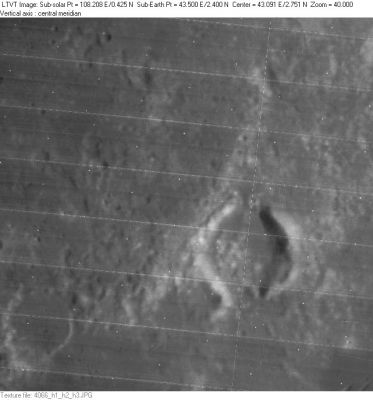Difference between revisions of "Secchi"
| Line 25: | Line 25: | ||
** Cherrington, 1969: 1.58 km | ** Cherrington, 1969: 1.58 km | ||
* Central peak height | * Central peak height | ||
| − | ** [[Sekiguchi%2C%201972|Sekiguchi, 1972]]: a broad elevated part of the floor rises less than 0.5 km <span class="membersnap">- | + | ** [[Sekiguchi%2C%201972|Sekiguchi, 1972]]: a broad elevated part of the floor rises less than 0.5 km <span class="membersnap">- fatastronomer</span> |
<br /> | <br /> | ||
==Nomenclature== | ==Nomenclature== | ||
Latest revision as of 20:39, 16 April 2018
Contents
Secchi
|
Lat: 2.4°N, Long: 43.5°E, Diam: 22 km, Depth: 1.35 km, Rükl: 37 |

Images
LPOD Photo Gallery Lunar Orbiter Images Apollo Images
- Secchi A and Secchi B, a pair of bowl-shaped craterlets at 3°30' north/ 41°30' east, was captured on frames 2021 to 2024, made by Lunar Orbiter 2. Frame 2024 shows both craterlets (Secchi A near the centre), while nearby Taruntius F is seen on Frame 2021.
- Secchi K was captured on Apollo 10's AS10-29-4261. Note the double ray of the Messier twins in the frame's upper left section!
- The bowl-shaped crater Secchi X (which was called "Lost Crater" during the hey-days of the first orbital Apollo missions) and the nearby Rima Messier, were captured on Lunar Orbiter 5's Frame 047.
- Secchi X (the "Lost Crater") was also captured on Lunar Orbiter 1's Frame 1067.
- Research Lunar Orbiter and Apollo 10 photography: Danny Caes
Maps
(LAC zone 61C4) LAC map Geologic map AIC map LTO map
Description
Description: Elger
(IAU Directions) SECCHI.--A partially enclosed little ring-plain S. of Taruntius, with a prominent central mountain and bright walls. There is a short cleft running in a N.W. direction from a point near the W. wall. Schmidt represents it as a row of inosculating craters.
Description: Wikipedia
Additional Information
- Depth data from Kurt Fisher database
- Pike, 1976: 1.35 km
- Arthur, 1974: 1.91 km
- Westfall, 2000: 1.35 km
- Viscardy, 1985: 1.9 km
- Cherrington, 1969: 1.58 km
- Central peak height
- Sekiguchi, 1972: a broad elevated part of the floor rises less than 0.5 km - fatastronomer
Nomenclature
Pietro Angelo; Italian astronomer, astrophysicist (1818-1878).
LPOD Articles
Seeking Secchi
Little Treats (Secchi X and environs, by Lunar Orbiter 5)
US-1 and other Signposts (an extraordinary LPOD of the equatorial zone at Maskelyne-Secchi, which shows a bonanza of NASA-related nicknames!)
Bibliography
-drawing:
A Portfolio of Lunar Drawings (Harold Hill), page 23.
Angelo Secchi in the Sourcebook Project (William R. Corliss)
- In Mysterious Universe, a handbook of astronomical anomalies (1979) :
- Page 6: The Corona (C.A.Young, The Sun, 1896).
- Page 9: Bulges on the Sun's Limb (Dorrit Hoffleit, Sky and Telescope, 1954).
- Page 480: On the Reversed Curvature of the Shadow on Saturn's Rings (Aldro Jenks, Sidereal Messenger, 1890).